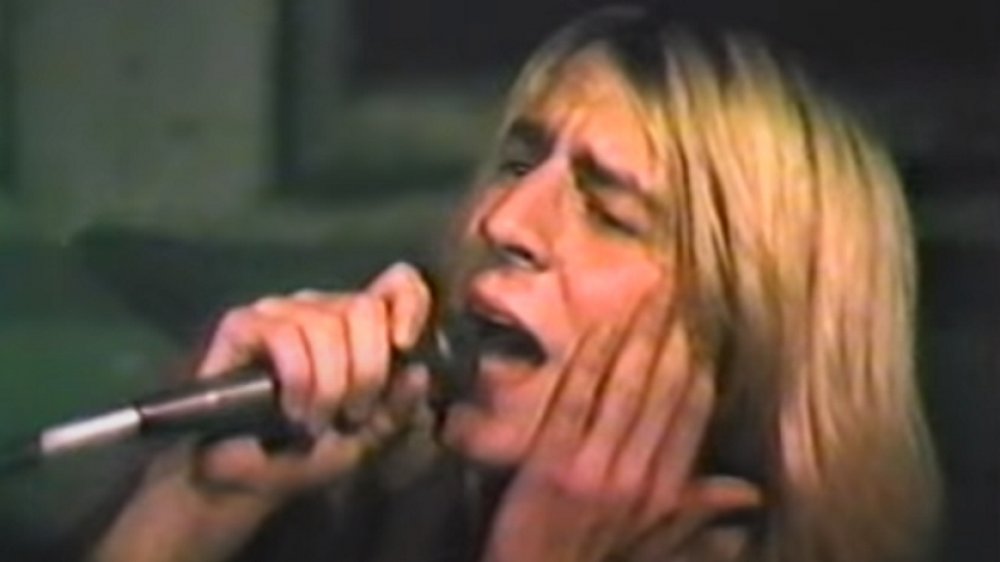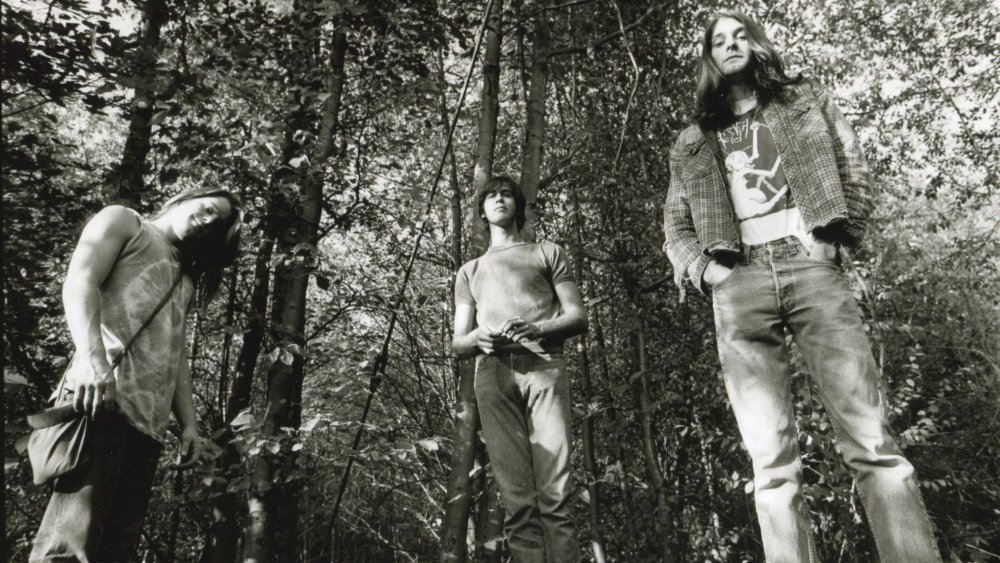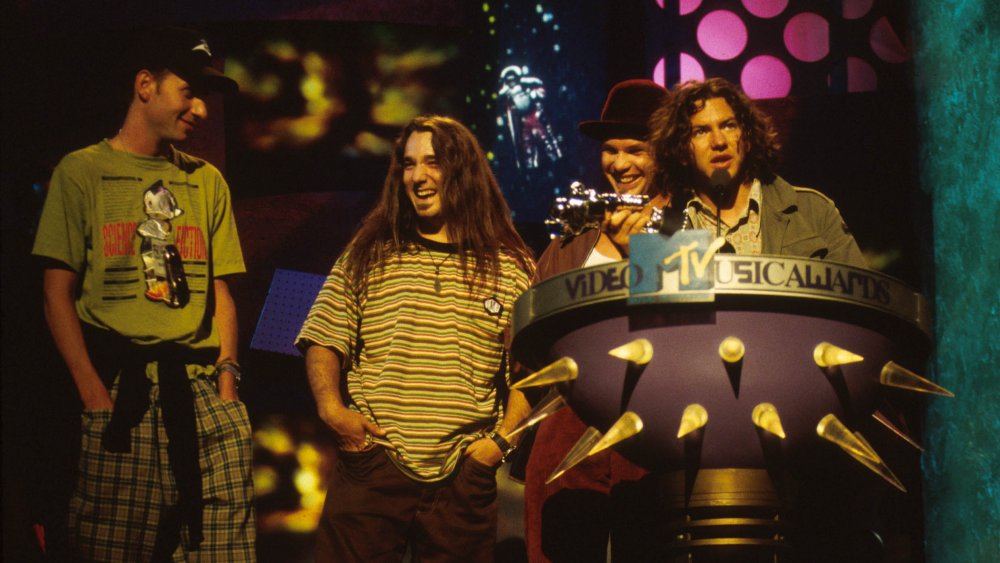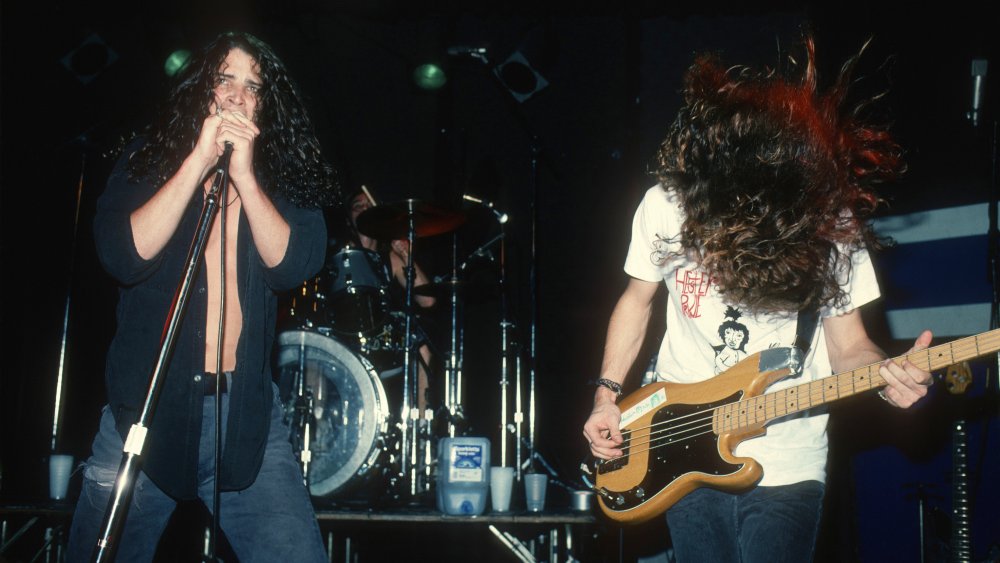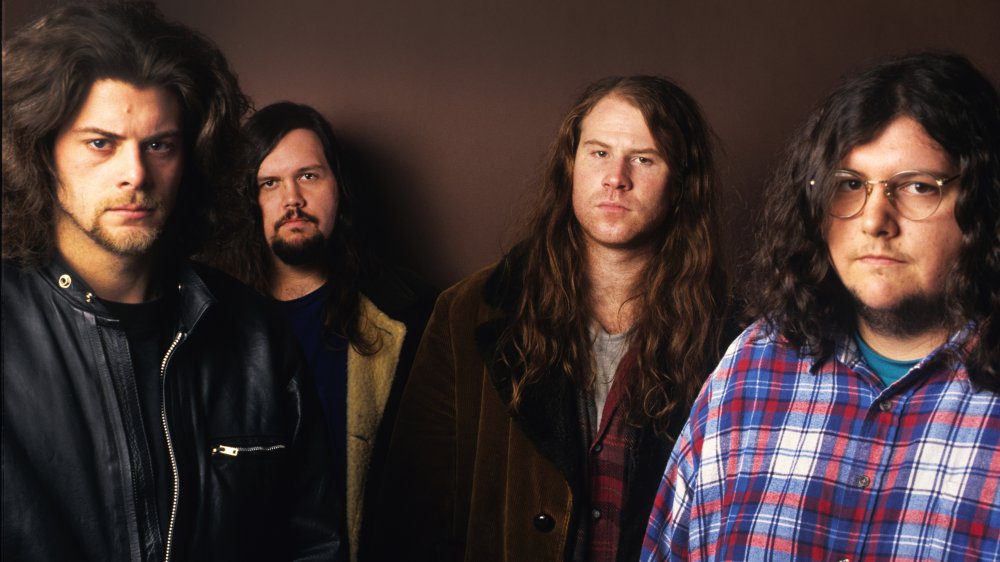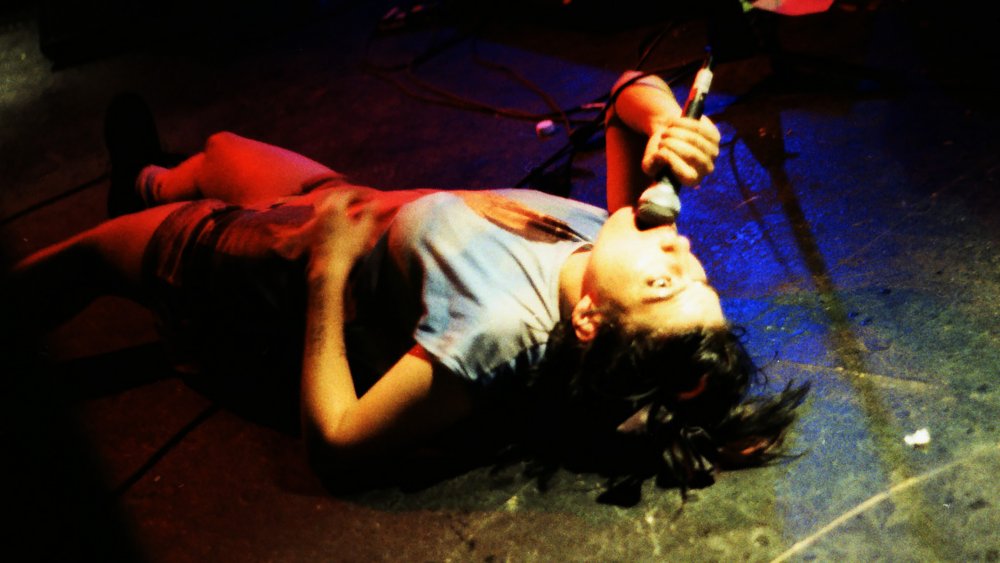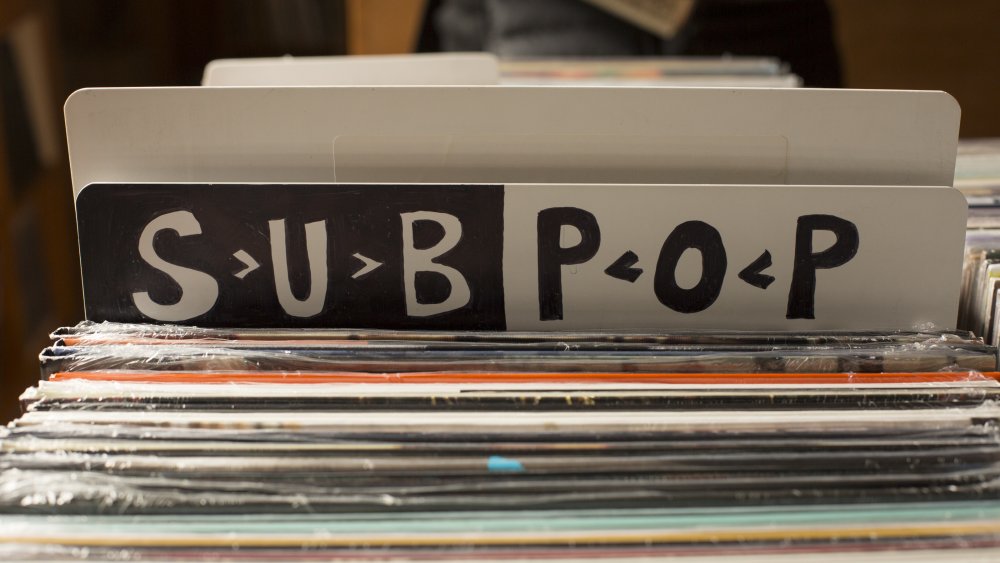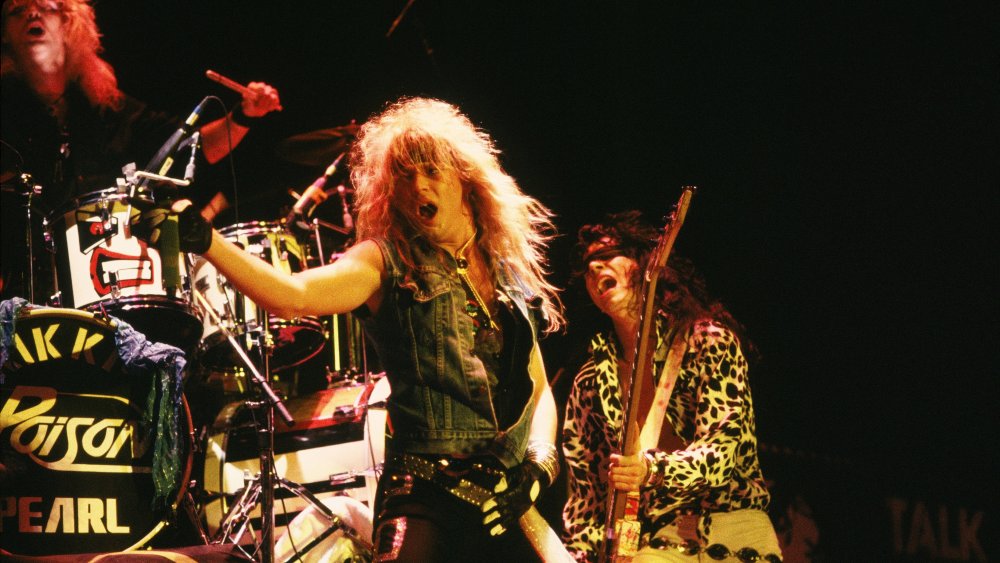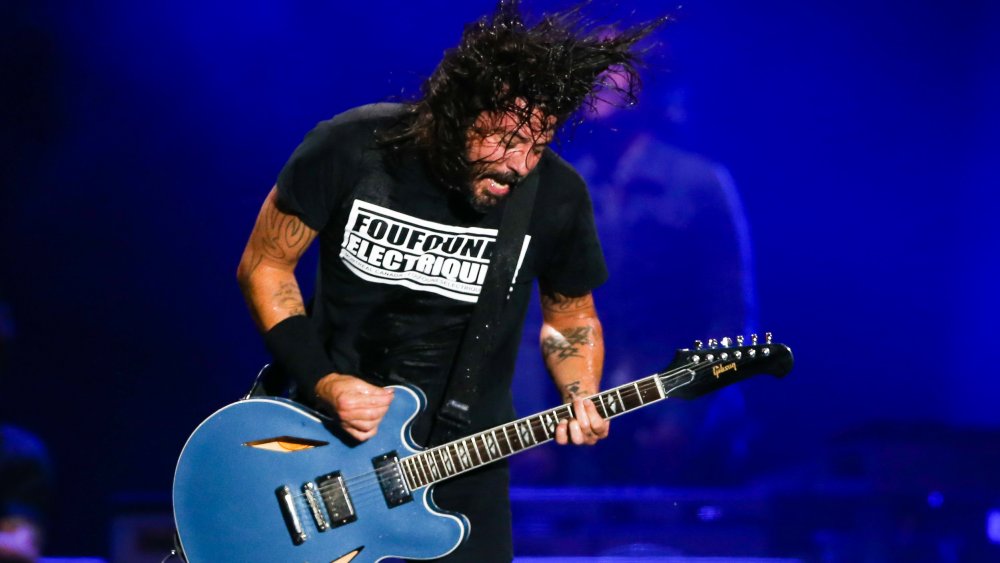The Untold Truth Of Grunge Music
It was the right music at the right time. Fusing the fury and conscience of punk with a stripped-down, sludgy guitar sound that was equal parts Black Sabbath and Black Flag, grunge exploded from the Pacific Northwest underground in the late '80s. Eschewing the pretense and flash of the glam metal that had dominated the airwaves for the better part of the previous decade, bands like Nirvana, Pearl Jam, Alice in Chains, and Soundgarden spoke to a generation that couldn't relate to the party-hard superficiality of Poison. Throughout the early '90s, grunge was a worldwide phenomenon inspiring mainstream fashion and culture. Seattle became a musical Mecca on par with Liverpool in the early '60s. At the height of grunge's popularity, music magazine Spin famously declared "Seattle is currently to the rock 'n' roll world what Bethlehem is to Christianity." However, by the mid-'90s, the scene and its brightest stars began to collapse under all that hype. Although grunge music was as vital as ever, the prevailing culture moved on to teen-oriented pop music and hip-hop.
In the intervening years, grunge was largely regarded as a passing cultural fad, with its history as a once-thriving and fiercely original music clouded by overexposure and fanfare. Three decades later, the mythology around grunge persists. Nevertheless, the untold truth is out there.
The Seattle scene had peaked by the time grunge hit
According to a 1992 article published in Rolling Stone, the Seattle alternative music scene that would come to be known as grunge had peaked in 1989, years before it became an international phenomenon. The four key bands that would form the cornerstones of grunge — Alice in Chains, Pearl Jam, Nirvana, and Soundgarden — had all signed with major labels and left the Seattle underground by the early 1990s. Stylistically, even those bands had changed direction from the characteristically murky sound of the Seattle underground, with Nirvana specifically pursuing a more pop-oriented musical aesthetic.
As chronicled by Northwest Passage, a website dedicated to preserving the history of the late '80s and early '90s Seattle scene, grunge as a pure musical statement defined by a fuzz, feedback, and a fusion of punk and heavy metal had become so diluted by the early 1990s that the mainstream applied the term to any band hailing from the Northwest. Ironically, bands like Green River and the U-Men, who popularized grunge in its original incarnation, had broken up by 1990, and scene stalwarts Soundgarden and Mudhoney were exploring different musical territory.
It all started with a joke
Although his name may not be as well-known as grunge icons Kurt Cobain, Eddie Vedder, Chris Cornell, or Layne Staley, Mark Arm, born Mark Thomas McLaughlin, was one of the most influential figures in the '80s and '90s Northwest music scene. Singer for both the seminal Green River and Mudhoney, Arm's fingerprints are all over the story of grunge. He may have been the first musician to apply the term "grunge" to the Seattle music scene. In author Mark Yarm's 2011 book, Everybody Loves Our Town: An Oral History of Grunge, Pravda Records co-founder Marie Masco reveals the story behind Arm and the appellation that would define a genre: "[Music fanzine] Desperate Times has letters to the editor, and Mark wrote this letter complaining about his own band, Mr. Epp and the Calculations, being 'pure grunge.' Before that, the word had been grungy, an adjective. Mark basically turned it into a noun."
Humorously lambasting his joke band (named for vocalist Jo Smitty's high school math teacher), the future Mudhoney frontman wrote, "I hate Mr. Epp and the Calculations! Pure grunge! Pure noise! ..." Cultivating a reputation as "the worst band in the world," Mr. Epp was active from 1980 to 1984. Soon after, Arm would form Green River, one of the most important bands in the history of grunge.
Green River was grunge's common denominator
As documented by Rolling Stone in a 2019 article commemorating the reissue of their catalog, no band is as integral to grunge as Green River. Combining the attitude of hardcore punk with the thundering riffs of '70s hard rock, Green River encapsulated the grunge ethos better than any other Seattle band. Taking their name from a notorious Washington state serial killer and a Creedence Clearwater Revival song, Green River came together in 1984.
Formed by Mr. Epp alumnus Mark Arm, guitarist Steve Turner, drummer Alex Vincent, and bassist Jeff Ament, the band released their debut EP Come on Down in 1985. Predating the band's appearance alongside early recordings by the Melvins and Soundgarden on the essential 1986 indie compilation Deep Six, Come On Down is considered by many to be the first grunge record.
Adding guitarist Stone Gossard to the lineup to free Arm from guitar duties, Green River would follow Come On Down with another EP, 1987's Dry as a Bone (promoted by record label Sub Pop as "grunge that destroyed the morals of a generation"), and their only full-length album, 1988's Rehab Doll, before calling it quits. Following Green River's demise, Arm and Turner would go on to form the influential Mudhoney, while Ament and Gossard would find superstardom in Pearl Jam.
Nirvana wasn't a Seattle band
Both grunge's greatest success story and most devastating tragedy, no band is as synonymous with the Seattle underground music scene as Nirvana. However, as important as Nirvana was, their reputation as a Seattle band was, at best, tenuous. As Everette True, a journalist close to the band during its meteoric rise, relates in a myth-breaking article in The Guardian, frontman Kurt Cobain and bassist Krist Novoselic grew up in Aberdeen, Washington, while drummer Dave Grohl was an import from Washington, DC. Despite their success in the Northwest music scene, Cobain and Novoselic chose to reside outside its hub, moving to nearby Olympia and Tacoma, respectively, to save on rent. As Nirvana's groundbreaking second album Nevermind was climbing the charts, Cobain still chose to live in Olympia, eventually moving to Los Angeles at the height of the band's success before finally settling in Seattle for the last 13 months of his life.
Nicholas Soulsby, author of I Found My Friends: An Oral History of Nirvana and curator of the website Nirvana Legacy, makes a convincing argument that Nirvana was more of a California band than a Seattle band. Citing tour itineraries dating to the release of their first album Bleach in 1989, Soulsby points out that Nirvana's presence in the Northwest was greatly diminished. With their 1991 major label release Nevermind, it was crucial for the up-and-coming band to develop the biggest following possible, and California's ratio of big city venues eclipsed Washington's.
Pearl Jam were considered sellouts
Nearly every discussion of grunge deteriorates into the eternal argument of which band was better, Pearl Jam or Nirvana? Although the debate still rages among rock fans, many grunge insiders, including Nirvana's Kurt Cobain, were highly critical of Pearl Jam and its ascent to mainstream success. According to a 2017 band retrospective published in The Seattle Times, Pearl Jam didn't do things the "Seattle way." As Cobain biographer Charles R. Cross states in the article, "[Pearl Jam] were criticized by Kurt Cobain and others as careerists, but every band in town wanted success. For some reason, the populism of Pearl Jam — writing anthemic rock, striving to be a band that gets on the radio — these were things that, in Seattle, were not the way people acted. You were supposed to play a bunch of shows nobody saw, release three or four crappy singles on alternative labels and not be a success, and THEN break through. Pearl Jam didn't follow those rules."
The scene's cliquish sensibilities marked San Diego-born vocalist Eddie Vedder an outsider. Despite his powerful voice and solid songwriting skills, he often found himself in the shadow of Andrew Wood. Wood, the charismatic singer for Mother Love Bone, Pearl Jam members Jeff Ament and Stone Gossard's previous band, died of a heroin overdose on the cusp of the band's major label debut. Band photographer Lance Mercer walked out of Pearl Jam's first gig, stating that he felt Vedder didn't deserve to be there.
Soundgarden beat everyone to a major label
Although Nirvana quickly became the mainstream's grunge poster boys with the release of Nevermind on Geffen Records, Soundgarden was the first band to break away from the indies and land a record deal with a major label, per Rolling Stone.
Following two successful EPs, Screaming Life and Fopp, the band jumped ship from Seattle's Sub Pop records to Black Flag guitarist Greg Ginn's SST label, home of legendary hardcore acts the Minutemen and Bad Brains, for their first full-length release Ultramega OK. As detailed on the website UDiscoverMusic, Soundgarden initially believed that they had made the best decision. However, they were ultimately dissatisfied with the final mix.
For their next release, the band signed with major label A&M. The result was the landmark album Louder Than Love, a grinding, riff-laden wall of noise that would pave the way for grunge's assault on the mainstream. Not only would Chris Cornell and company be grunge's first major label players, but they would also the genre's first act to chart, with Louder Than Love reaching number 108 on the Billboard Top 200 in 1990.
Only a handful of grunge bands made it big
Although grunge seemingly took over the world in the early '90s, only a small number of bands attained mainstream fame. Aside from grunge's so-called "big four" of Nirvana, Pearl Jam, Soundgarden, and Alice in Chains, most grunge bands, like their punk rock progenitors, never rose above much more than a cult following. Although grunge superstars like Kurt Cobain constantly name-checked their influential peers, that never translated into widespread recognition for such bands as the Melvins, Screaming Trees, and TAD. As detailed by Diffuser, even the frequent cross-pollination of Seattle bands left influential figures like Bruce Fairweather of Mother Love Bone and Jason Everman, who drummed for both Nirvana and Soundgarden, out of the spotlight.
As the hype around the Seattle music reached its crescendo in the early '90s, major labels smelling quick profits stormed the Pacific Northwest to sign grunge acts. According to Northwest Passage, the recording industry's mad dash to find the next Nirvana or Pearl Jam destroyed some of the scene's most innovative bands. Among the casualties were TAD, Hammerbox, Flop, and 7 Year Bitch, who all dissolved when their major label debuts failed to meet even the moderate success of Screaming Trees and the Posies, let alone the lofty heights reached by Nirvana.
Women were the unsung heroes of grunge
As detailed by the progressive website This, the popular media of both the '90s and today would lead you to believe that grunge was a male-dominated scene. Although the men of grunge received the lion's share of press coverage and airplay, the genre was far from a boys-only club. The women of the '90s Northwest scene rocked just as hard as the men, battled the same demons, and surmounted more obstacles. From Olympia, Washington's, notorious Riot Grrrls to Bikini Kill, led by Kathleen Hanna, to the pure punk fury of the Gits, fronted by the late Mia Zapata, the women of grunge carved out a sonically unique niche in the scene with a music-first attitude that was fiercely feminist.
For all their unsung triumph, the women of grunge also faced largely unsung tragedy. While the deaths of Kurt Cobain, Layne Staley, Chris Cornell, and even Andrew Wood are regularly memorialized, eulogized, and otherwise mourned, many women vital to grunge met with sad, sometimes violent ends unheralded by the press. Among the casualties are the aforementioned Zapata, who was brutally raped and murdered on her way home from a Seattle club in 1993, 7 Year Bitch guitarist Stefanie Sargent, who, like so many of her male contemporaries, succumbed to a heroin overdose in 1992, and Hole's Kristen Pfaff, who was also felled by drug addiction.
Grunge fashion was born of practicality and poverty
Much to the chagrin of the musicians who made grunge a phenomenon, the concept of grunge fashion became a huge part of marketing the music to America. Flannel shirts, ratty cardigan sweaters, thermal underwear, ripped jeans, and chunky combat boots — the no-nonsense clothing of both the streets and the backwoods became an ironic fashion statement for middle America in the first half of the '90s.
As recounted in an article chronicling the rise and fall of grunge posted by the website Culture Trip, the trend of grunge fashion, which was inexplicably co-opted by upscale fashion mavens like Mark Jacobs and middle-class department stores like Macy's, was born of a strictly anti-fashion ethic based on poverty and practicality. There are two universal truths in the development of grunge fashion: Young people, and especially musicians, are often broke, and Seattle is cold and wet. If you were a struggling musician in the Pacific Northwest, you knew that flannel and thermals were cheap (and even cheaper secondhand) and, more importantly, warm. You made do with ripped jeans, and clunky, durable combat boots provided both protection and traction on Seattle's perpetually rain-slicked streets.
Grunge-speak: Sub Pop's hoax heard around the world
Remember the hip, grunge-inspired lingo that had all the cool kids talking about wack slacks and lamestains? Neither do we. As recounted by Vulture, grunge-speak was a brilliant, off-the-cuff prank perpetrated by a 25-year-old receptionist employed by a Seattle indie record label on an unwitting New York Times reporter.
In 1992, grunge music and fashion had captured the imaginations of young people across the world. Smelling an as-yet untold story in the making, New York Times reporter Rick Marin was determined to reveal some new details about the coolest subculture going. He decided that the best, most logical place for the real inside info was the hottest indie record label in Seattle, Sub Pop. Marin called the label, inquiring about the unique language of the grunge subculture. From jazz to hip-hop, all the great musical subcultures had their own lingo. Surely grunge was no different.
Enter Megan Jasper, Sub Pop receptionist and soon-to-be grunge legend. Answering the "Styles and Times" reporter's call and query, Jasper, knowing that the Pacific Northwest music scene had no specific slang to speak of, made some up on the spot. To Jasper's befuddlement, the Times ran with it, and some people even began using her made-up grunge-speak. Here are some examples as cited by PRI: Grunge kids didn't merely spend their time hanging out — they were "swingin' on the flippity-flop." Torn jeans were "wack slacks." Pathetically uncool people were "lamestains," and really pathetically uncool people were "cob nobblers."
Grunge didn't kill hair metal
The most prevalent myth of grunge music is that it killed off '80s hair metal. Nearly every TV documentary chronicling decadent, pop-oriented heavy metal's rise and fall has that moment when a former glam metal hero will intone words to the effect of "and then it all came crashing down," followed by the ominous opening chords of Nirvana's "Smells Like Teen Spirit." In retrospect, grunge is merely an easy scapegoat for hair metal's demise.
In an interview with Kerrang, Mötley Crüe's Nikki Sixx reveals the truth behind the demise of bands like Poison and Warrant: "I have to say that I don't think that Nirvana and Pearl Jam killed the bands you mention, I think that they killed themselves. They were making copycat music." Former TNT vocalist Tony Harnell echoes Sixx's assessment in a 2019 article from Blabbermouth detailing his recent appearance on the Cobra and Fire podcast. According to Harnell, grunge was exactly the change that rock needed. "If anything, when Nirvana and Soundgarden and these bands came out, all it did is it shined a really harsh light on how boring and repetitive everything got."
Grunge is dead ... long live grunge
As a pop culture phenomenon, grunge died in the late '90s. Although fans and journalists argue for such moments as Kurt Cobain's suicide or Soundgarden's breakup in 1997 as grunge's definitive end, the truth is that no specific event marked the genre's death.
However, an argument can be made that grunge never died at all. The loud guitars and anti-fashion attitude merely evolved. The genres of doom metal, sludge, desert rock, and stoner rock which rose to prominence in the 2000s share a common ancestry informed by both grunge and its '70s hard rock and punk roots, with grunge pioneers the Melvins influencing everyone from modern grindcore bands to Seattle's current masters of ambient drone Sunn O))).
One notable advocate for grunge's survival is none other than former Nirvana drummer and Foo Fighters founder and frontman Dave Grohl. In a 2013 post, NME quotes Grohl's response to a fan's Reddit question about the possibility of a grunge comeback: "If you mean loud ass guitars, loud ass drums, and screaming ass vocals? That never went away..."



